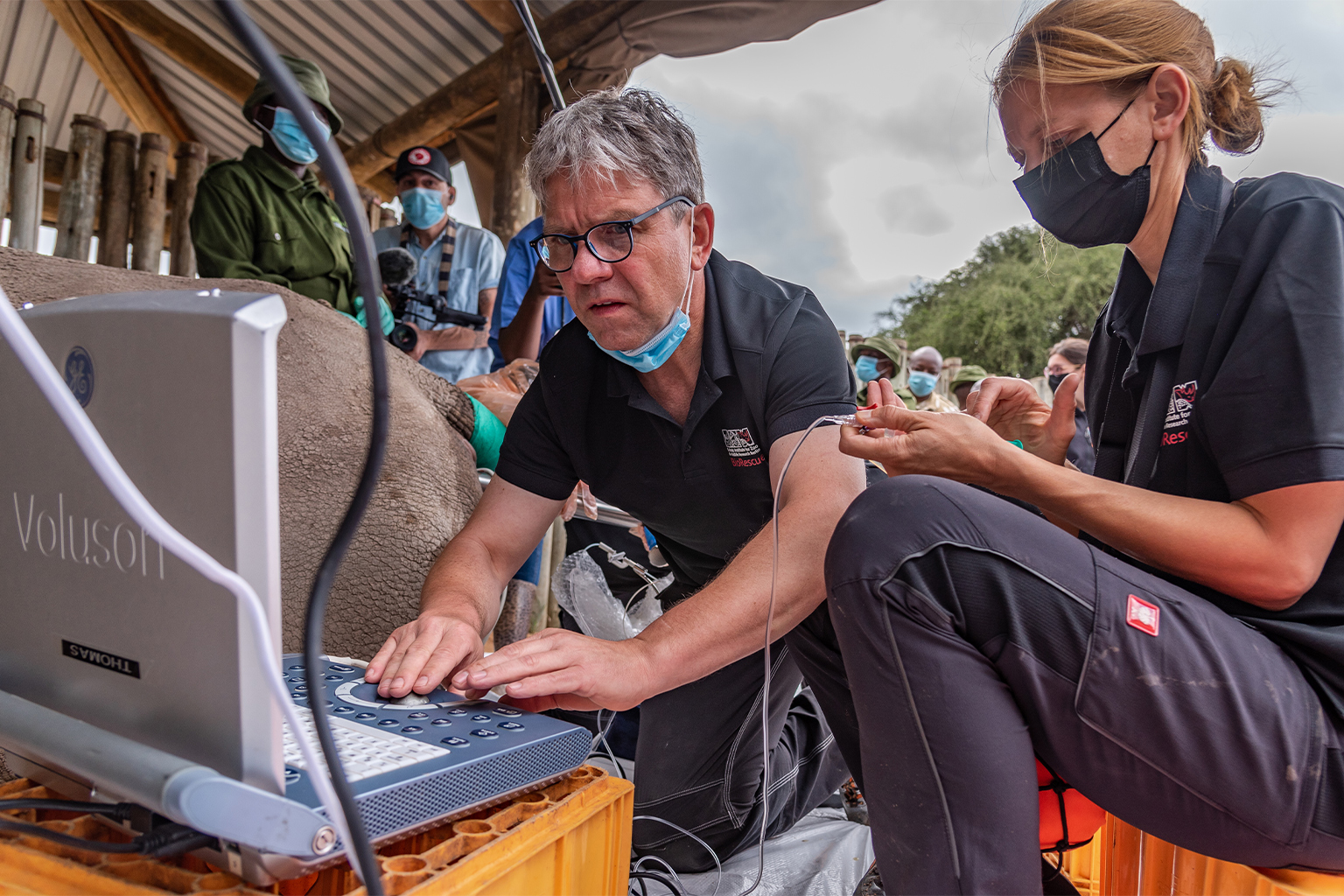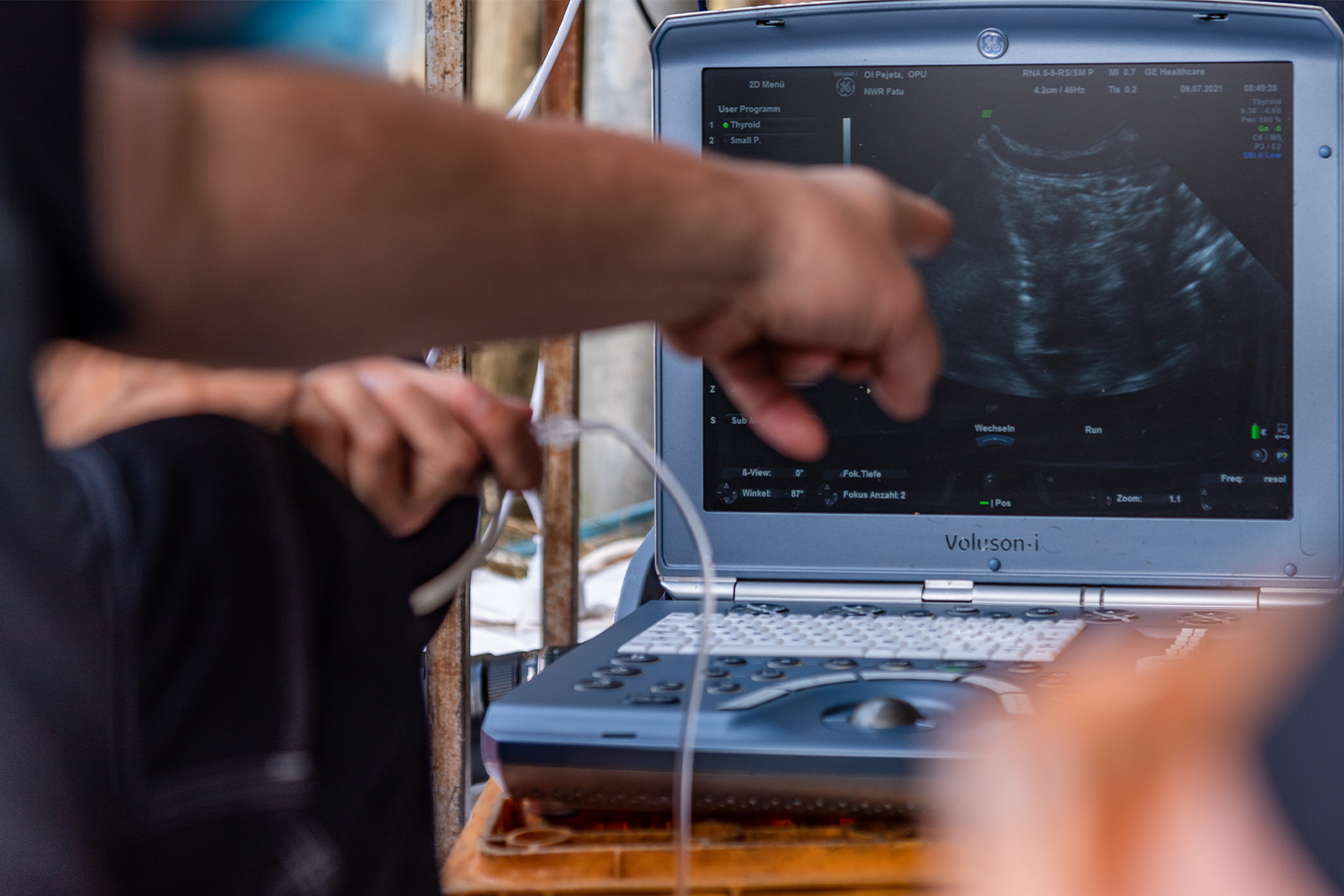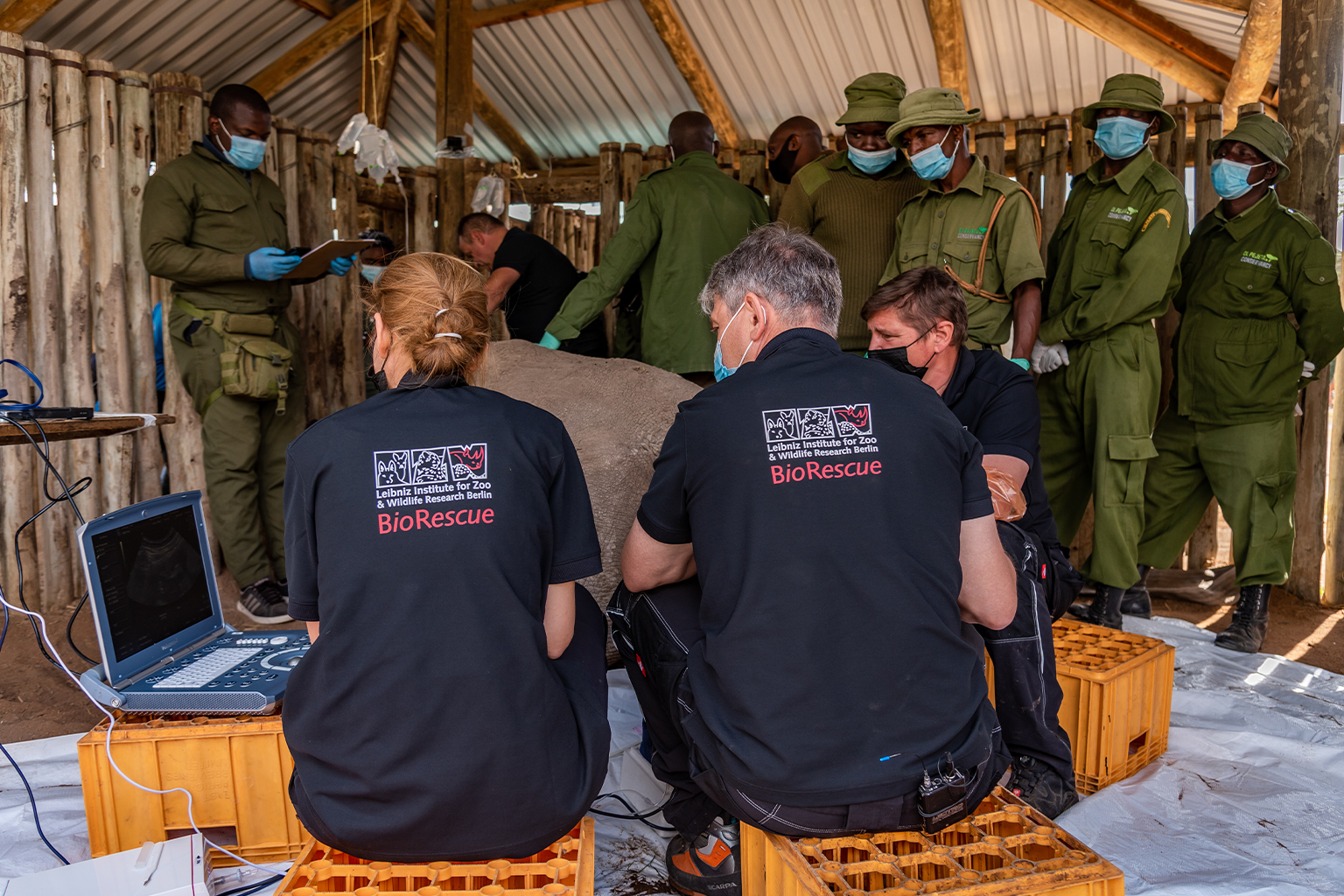
- In July, BioRescue announced the creation of three new northern white rhino embryos, bringing the total to 12.
- Project leader Thomas Hildebrandt said he hopes to transfer a northern white rhino embryo into a female southern white rhino by the end of the year.
- Researchers and stakeholders are assessing whether it would be possible to employ similar methods to preserve genetic diversity in critically endangered Asian rhino species, weighing the risks of extracting eggs against the need for a backup plan.
In early July, the ephemeral promise of a new life blinked into existence. Not in the usual way, but on a clear microscope slide in a sterile lab in Cremona, Italy, thousands of miles from the creature’s ancestral territory in sub-Saharan Africa. Shortly after, lab technicians plunged it into liquid nitrogen, freezing the creature’s development by rapidly bringing its temperature to −196° Celsius (-321° Fahrenheit).
Though only a few cells in size, the embryo, one of three produced this spring, represents hope for the virtually extinct northern white rhinoceros (Ceratotherium simum cottoni).
BioRescue — a consortium made up of Leibniz Institute for Zoo and Wildlife Research (Leibniz-IZW) in Germany; Safari Park Dvůr Králové in the Czech Republic; the Kenya Wildlife Service; and Ol Pejeta Conservancy in Kenya — announced the creation of the embryos in July, bringing the total northern white rhino embryos to 12. The announcement marks a major achievement for the subspecies, which has only two remaining members: a mother-daughter pair who are both incapable of carrying a calf.
Notably, one of the embryos was created using genetic material from a male rhino named Angalifu, whose sperm was previously thought to be too low in quality to produce viable offspring, adding vital genetic diversity to the pool of embryos. All other embryos to date have been created with sperm from a northern white rhino bull named Suni.
Some scientists believe that the innovations pioneered by BioRescue and other groups might offer hope not just for the northern white but for other rhino species as well. Others argue that the last-ditch efforts might mean we have already failed.

Proof of concept
BioRescue has a bold strategy: implant the northern white rhino embryos into females of the southern white rhino (Ceratotherium simum simum), a closely related subspecies that has the same gestational period as its northern cousin. In theory, calf development should proceed similarly, allowing researchers to buck nature and produce offspring from a subspecies with no reproductively capable females.
Najin and Fatu, the last two remaining northern white rhinos on the planet, are housed at Ol Pejeta Conservancy in Kenya, where they were moved in 2009 from the Dvůr Králové zoo. Scientists harvest their eggs every three to four months, then airlift them to the Avantea lab in Cremona, where they are processed and stored. In the most recent cycle, researchers decided not to collect eggs from Najin, the elder of the two rhinos, due to her age and the condition of her remaining eggs.
The veterinary term for egg retrieval is “ovum pickup,” a technique that was first developed for cows and other large livestock. In humans, egg retrieval is a relatively simple procedure with little risk of complications; many women are in surgery for fewer than 15 minutes. By contrast, even minor errors during rhino ovum pickup procedure can kill the patient, compounding the already considerable risk of putting a 1,700-kilogram (3,750-pound) wild animal under anesthesia.

According to Thomas Hildebrandt, chair of wildlife reproduction medicine at Freie Universität Berlin, the years-long efforts to produce a calf may soon come to fruition. If things go well, he said, one of the 12 northern white rhino embryos could be implanted into a female southern white rhino soon.
“Our big plan … would be to [transfer a northern white rhino embryo] — and I’m always a bit overambitious, but that might be necessary for a project like this — before the end of the year,” Hildebrandt told Mongabay in an interview in August.
The speed of the project is necessary: as Najin and Fatu age, the window narrows for socializing a new calf, risking the loss of vital social knowledge that helps the subspecies survive in its natural range. Southern white rhinos, while closely related, have evolved to thrive in a significantly different habitat.
To ensure the viable embryos are used effectively, BioRescue must first test the process using southern white rhino embryos to prove that a healthy calf can be born from a lab-created embryo.
Researchers have another option up their sleeve. Barbara Durrant, San Diego Zoo’s Henshaw Endowed director of reproductive sciences, told Mongabay about another technique, pioneered by BioRescue and San Diego Zoo in parallel, that may make it possible to create viable embryos without sedating females for ovum pickup.
In this case, researchers collect cells from another part of the rhino’s body, typically the skin, and use chemical reprogramming agents to revert the cells to stem cells. Scientists can then cue these stem cells to develop into reproductive cells, creating embryos with all of the genetic material necessary for full development. This strategy is vital for the long-term survival of the subspecies because long-dead rhinos with no preserved reproductive cells can be included in the gene pool.
“Our goal is to create a self-sustaining population of northern white rhinos,” Durrant said. Without the added genetic diversity, northern white rhinos might be subject to the genetic bottlenecks that have plagued other subspecies returned from the brink of extinction, such as the Florida panther (Puma concolor coryi).
The method has produced viable embryos and offspring before, but only in lab mice. Even so, the members of both teams are optimistic. For now, the cell cultures reside in a facility at San Diego Zoo called the Frozen Zoo, which houses genetic material from more than 800 species and subspecies.
According to Durrant, this strategy could potentially be used with the Javan rhino (Rhinoceros sondaicus), for which ovum extraction isn’t possible because there are no captive individuals. As a result, less-invasive collection techniques suitable for wild animals could be a massive boon to conservation efforts.
Both Durrant and Hildebrandt say that banking genetic material now, while both the Javan and Sumatran rhino (Dicerorhinus sumatrensis) species have fewer than 100 individuals, may be vital insurance against the prospect of further population depletion. Still, the groups hope it won’t come to that.

An ethical dilemma
For Barbara De Mori, director of the Ethics Laboratory for Veterinary Medicine, Conservation and Animal Welfare at the University of Padua in Italy, the work being done to save the northern white rhino is about more than just saving the subspecies.
“When you are in front of [Najin and Fatu], it’s really very emotionally intense,” De Mori told Mongabay about seeing the two rhinos in the Ol Pejeta sanctuary, which she visits regularly to monitor veterinary procedures and collaborate with project scientists.
“You see your responsibility … both for having caused this situation and being forced to apply such an emergency project to save the species from the brink of extinction. And you see the responsibility to try to give them a chance.”
De Mori’s lab group is responsible for conducting intensive ethical assessments for each procedure involving Najin and Fatu. The scope of the ethical assessments is wider than the animals themselves: the group also factors in staff safety, transparency with local partners, and the ability to involve local people.
With the northern white rhino, the choice to collect eggs by sedating the last two animals is relatively clear: go to drastic lengths to save the subspecies through artificial means, or lose it altogether.
But at present, the decision is not so simple for those charged with protecting other critically endangered rhino species. Researchers have not yet proven the cell line techniques of BioRescue and the Frozen Zoo, meaning that egg extraction may be the only artificial method available.
The benefit of extracting an egg, a precious lifeline for a species that may disappear, might not outweigh the unlikely, but very real, possibility of losing a breeding female to complications during the procedure. Anesthetizing a rhino is no easy business.
Conservation managers may decide that natural breeding is a safer way to produce calves. And to date, lab-grown rhino embryos are still unproven; there have been no successful births.

“Natural breeding with Sumatran rhinos is proven,” said Nina Fascione, executive director of the International Rhino Foundation. “The artificial reproductive technologies are kind of supplemental to that.”
Fascione said an international husbandry board meets regularly to discuss the relative risks and merits of different reproductive strategies, including which rhinos to breed.
In the case of the Sumatran rhino, they are also deciding which individuals to capture from the wild for captive breeding, which runs its own gamut of ethical issues. Though the efforts have been hindered by the ongoing COVID-19 pandemic, Indonesian groups and staff are continuing monitoring and breeding efforts even as much of the country is in lockdown.
Terri Roth, vice president of conservation and science and director of the Conservation and Research of Endangered Wildlife (CREW) unit at Cincinnati Zoo & Botanical Garden, oversaw the only successful effort to breed Sumatran rhinos in the U.S. A reproductive physiologist by training, Roth is a proponent of rigorous natural mating programs and intensive conservation efforts over high-tech solutions, although she did note that the two strategies typically draw from non-overlapping funding pools.
“Taking on what [BioRescue] has taken on in attempting to [produce calves from lab-grown embryos] is a huge undertaking and it’s not something that I was ever interested in pursuing because of basically the pretty low return on investment,” Roth said. “But others feel differently and that’s OK … We hope they’re successful.”
Roth said that using another species as a surrogate isn’t in the cards for the Sumatran rhino, a diminutive (for a rhino) forest dweller. The species is the only member of the genus Dicerorhinus, so no other rhino species has similar enough reproductive equipment to carry a Sumatran rhino calf to term.
Still, Roth said it might be possible to create Sumatran rhino embryos and implant them in same-species surrogates to maximize genetic diversity — but only if a population of healthy breeding females remains. She cautioned that the method is not a replacement for natural breeding plans or habitat conservation.
“What I try to warn people, though, is that producing one calf does not save a species. It might prove that the technology is possible … but it’s going to take a lot more than that,” she said.

A future for rhinos
While experts may have differences of opinion on the best paths forward, all seem to agree on one point: we should never have let northern white rhino numbers dip so low in the first place. And, for ongoing conservation efforts to have any chance of success, other rhino population numbers must never become so perilously low.
“We should never be in a position where we know the names and birthdays of every damn animal,” Cathy Dean, CEO of the international nonprofit Save the Rhino, told Mongabay. Like many of the sources interviewed, Dean spoke with a sense of urgency. The organization focuses more directly on providing funding and other forms of assistance to on-the-ground partners in Africa and Asia, where they hope to stave off poaching and illegal trade in rhino horns in the remaining strongholds.
“I suppose Save the Rhino is wary of the argument that science will save us,” Dean said.
She added she hopes the attention given to the northern white rhino might drum up public support for other species that still have breeding populations in the wild. She cited the progress that Ol Pejeta Conservancy has made in preserving the critically endangered black rhino (Diceros bicornis), saying those efforts may largely have been funded by the attention afforded to their rarer relative.
“I would love to see more coverage of the black rhino successes, but nobody wants the success story,” Dean said. She spoke critically of the widespread media frenzy leading up to the 2018 death of Sudan, the last male northern white rhino. Dean said she fears similar attitudes will draw attention away from other necessary conservation efforts. “Watching the last two animals on the planet die seems to be more appealing.”

In spite of differing opinions on the best way forward, Dean and others in the international rhino conservation community work together closely, forming a small but dedicated and emphatically vocal coalition. Many among them agree that the efforts of BioRescue and the San Diego Frozen Zoo may become necessary, especially for the Sumatran rhino, which has a desperately small population. Should other efforts fail, experts may have no choice but to move forward with Hail Mary passes to save additional species.
“We have to keep the door open to anything and everything,” Dean said.
With a little luck, but mostly with a lot of scientific brainpower, one of the bundles of cells frozen in time will soon travel via courier back to Africa to quicken in the womb of a surrogate mother.
If successful, the calf will live in a mixed herd of southern and northern white rhinos, learning lessons on the grassy plains of Ol Pejeta Conservancy that would have been better taught years ago and miles away in its native range in sub-Saharan Africa.
Perhaps, experts suggest, the achievement will remind humanity that while we may be able to bring species back from near extinction, it’s still at a great cost and with much loss.
Banner image of Najin and Fatu by BioRescue/Rio the photographer.
Creation of three new northern white rhinos embryos may indicate hope for other rhino species
Source: Trends News

0 Comments